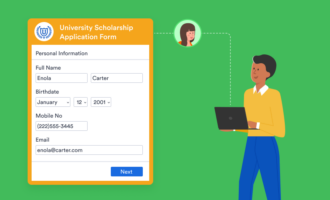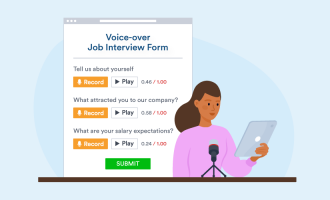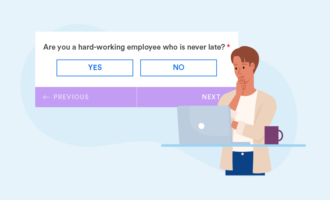4 quantitative data-collection methods
- Surveys
- Interviews
- Observation
- Document review and secondary data collection
Whether you want to improve your company’s services, identify potential new products, understand buyer motivations, increase customer satisfaction, or plan your next marketing campaign, data collection and analysis can help you make informed decisions about the best way to proceed.
The data you collect can be quantitative or qualitative. This article will focus on quantitative data-collection methods.
An overview of quantitative data collection
Quantitative data is measurable data researchers collect by asking closed-ended questions — such as multiple-choice, Likert scale, and dichotomous questions — using surveys, polls, questionnaires, and other methods. It helps researchers determine quantities, averages, patterns, trends, and other information.
Quantitative data can always be represented numerically. However, the questions used to collect quantitative data may have nonnumerical answer options. Take this question, for example:
Question: Do you work on weekends?
Answer options: Yes / No
The answer can either be “yes” or “no,” neither of which is a number. However, when you’ve tallied and analyzed the answers, you’ll get a numerical result, such as 10 “yes” responses and 25 “no” responses, which would allow you to determine that about 29 percent of respondents work weekends.
Here’s another example:
How often would you like to receive our newsletter?
- Once a week
- Every other week
- Once a month
Again, the answers themselves aren’t numerical, but once you’ve tallied them, you’ll have numerical results.
Quantitative data-collection methods can help businesses learn more about their customers, prospects, employees, and other stakeholders. They can also help organizations forecast sales and other important information.
A variety of organizations collect quantitative data, including educational institutions, nonprofits, sales companies, and businesses from many other industries.
There are two types of quantitative data collection: primary and secondary.
Primary quantitative data collection involves collecting the data yourself, such as by polling prospects, surveying customers, or interviewing focus groups.
Secondary quantitative data collection involves using data that someone else — such as a research organization or another business — has already collected. For example, many businesses use secondary quantitative data that industry leaders have collected because doing so is cost-effective and the data is often robust.
The difference between quantitative and qualitative data
Quantitative data is all about the numbers. In simple terms, this data is often gathered to answer how many.
Qualitative data is more descriptive and contextual, and it can help researchers understand people’s perceptions, behaviors, and motivations. Interview questions and open-ended surveys and questionnaires are two of the most common ways to collect qualitative data. In simple terms, this data is often collected to answer why.
You can find a more thorough discussion of qualitative vs quantitative data here.
The importance of quantitative data collection
Both quantitative and qualitative data have immense value. However, they yield different types of insights. Quantitative data has these benefits:
- It’s easy to verify. With quantitative data collection, researchers use closed-ended questions, such as multiple-choice or rating scales. These reduce ambiguity because participants must choose an answer from prewritten, definite responses.
- It provides objective results. The insights gathered from quantitative data are numbers-based, making the conclusions less subjective. For example, say a business surveys customers on whether they prefer the company logo in blue or red, and the majority of respondents choose red. The company can choose whether or not to act on this information, but the findings aren’t subjective — respondents clearly preferred red.
- It allows for hypothesis testing. Organizations can gather quantitative data to test a hypothesis. For example, if an organization thinks its target audience will respond favorably to a product idea, it can share the product with a small subsection of its audience and survey them for feedback. If the quantitative data shows that this group likes the product, as the organization suspected they would, the organization can release the product to a wider audience with greater confidence.
- It’s scalable. Not many organizations have the resources to survey their entire audience base. Instead, they survey smaller representative portions of their audience and then generalize the findings to the whole group. For example, if 67 percent of the smaller group surveyed indicate they want a monthly newsletter, the organization may assume that about 67 percent of the larger group will also want a monthly newsletter.
- It’s easily comparable. Researchers can easily compare quantitative data from different time periods and research samples. It’s relatively simple to spot trends or identify unusual behaviors when analyzing different groups of numbers. For example, if a quarterly customer satisfaction survey consistently yields positive scores, but the score suddenly drops during one quarter, the organization can quickly identify this result as abnormal and prioritize addressing the problem.
Strengths and weaknesses of quantitative data collection
Quantitative data collection offers many benefits besides the ones listed in the previous section. Quantitative data surveys are typically easier for respondents to fill out and creators to analyze compared to qualitative data surveys because they involve simple, straightforward questions with preselected answers.
Respondents simply have to select an answer from the provided options, which is much quicker than writing lengthy answers for a qualitative data survey.
It’s also simpler for survey creators to measure the results because the responses are numerical. This kind of data lends itself well to visual analysis and can quickly be turned into charts, graphs, and tables.
However, while quantitative data collection works well in many scenarios, it has one major downfall: It can’t provide the same depth of insight as qualitative data. Quantitative data can rarely answer “why” questions.
Another issue with quantitative data is that researchers need a sufficient sample size from which to make conclusions. It’s not possible to survey only 10 people and generalize the findings to a group of 10 million people. The sample size needs to be large enough in relation to the whole target audience. Using larger sample sizes can be more difficult and time-consuming.
Because both data-collection methods have pros and cons, many organizations gather both quantitative and qualitative data.
Quantitative data-collection methods
Surveys
Surveys are one of the most common quantitative data-collection methods. Unlike qualitative surveys, in which participants answer open-ended questions and can share as much detail as they’d like, quantitative surveys use closed-ended questions with preselected answer options.
Quantitative surveys are useful for gathering all kinds of numerical information, from demographic data to product ratings and satisfaction scales.
Pros
- Participants can complete surveys online, in person, on the phone, or through the mail.
- Surveys are cost-effective.
- Surveys are easy to scale to large groups of people.
- Survey responses can be identifiable or anonymous, giving researchers and participants flexibility.
Cons
- Some respondents don’t provide honest information in surveys, and it can be difficult to identify compromised data.
- Respondents sometimes return incomplete surveys.
When to use
Use surveys as a quantitative data-collection method when you want insight from large groups of people.
Types of surveys
- Online surveys: Online surveys are easy, quick, and cost-effective. Tools like Jotform let organizations easily build online surveys that can be accessed from any device and then email the surveys to their prospects and customers, embed them on their websites, or use social media to distribute them.
- In-person surveys: Surveys can be conducted in person at busy locations where a certain audience may be present (a community event or farmers market, for example).
- Mail surveys: Surveys can be mailed to potential respondents, along with prepaid return envelopes to encourage completion and return. While this method can entail large printing and mailing costs, it can work well in some contexts.
- Phone surveys: Surveys can be conducted over the phone. This method can help build a more personal relationship with respondents.
Interviews
You can also collect quantitative data through interviews. Quantitative interviews are very structured. Interviewers ask respondents closed-ended questions with a set of answer options that don’t allow for responses with detailed context.
Interviews can be conducted in person, on the phone, or online.
Pros
- Interviewing helps build a connection between the interviewer and the respondent.
- Researchers typically conduct one-on-one interviews, but small-group interviews are also an option.
- Interviews allow for more conversation than a simple question-and-answer format offers, making it easy to gather both quantitative data and qualitative information.
Cons
- Interviews may not be as cost-effective as other research methods because they can have high labor costs and be time-consuming.
- Most organizations can only interview small numbers of people due to cost and time restrictions.
When to use
Use interviews when your organization wants to foster a more personal relationship with respondents.
Types of interviews
- Virtual interviews: Virtual interviews using platforms like Zoom remove geographical restrictions on the interview pool. Researchers can reach respondents who live anywhere with an internet connection.
- In-person interviews: Researchers can read participants’ body language when they’re in the same room during an interview. This method is usually the most expensive and time-consuming type of interview.
Phone interviews: Phone interviews allow interviewers to reach interviewees anywhere with phone service. However, there’s no eye contact or nonverbal communication.
Observation
Observation entails researchers observing or counting subjects attending a specific event or using a service in a designated place. It’s a way to gather quantitative data while only interacting with subjects at a distance.
Collecting data this way is often referred to as “structured observation” — this is when researchers focus on observing and quantifying specific, narrowly defined behaviors.
Pros
- This quantitative data-collection method enables researchers to gather a large amount of data in one sitting.
- The data researchers collect is very specific to the research they’re conducting about the demographic or event, making it very relevant to specific scenarios.
Cons
- There’s often no interaction between the researcher and the subjects of observation, so this method can’t be used to build customer relationships or consumer engagement.
- Observation is dependent on the event or location. If researchers can’t be in the right place at the right time, they can’t gather the data they need.
When to use
Use observation when you want to quantify a specific behavior in your target audience in relation to a specific time or place.
Types of observation
- Structured observation: In structured observations, researchers observe a group of people to note a specific type of behavior and record its frequency. Examples of these behaviors include
- Shoppers choosing a specific product
- Attendees wearing event lanyards during an event
- Making a purchase at a trade show within a certain time frame
- Wearing concert merchandise immediately after purchase
- Parents holding their children’s hands inside a theme park
Document review and secondary data collection
The quantitative data collection-methods we’ve discussed so far involve gathering your own data. With document review and secondary data collection, on the other hand, you’re using someone else’s research — analyzing their data rather than gathering new data directly.
Pros
- Researchers don’t have to spend time and resources collecting their own data.
- Researchers can gather data from a broader pool of people by using other sources.
Cons
- The data you use might not be as relevant to your specific context as the data you gather directly.
When to use
Use document review and secondary data collection when you don’t have the time or resources to conduct your own research. This method also works well when you want to know something about a wide and varied target audience.
Types of document review and secondary data collection
- Document review: Researchers analyze quantitative data in primary documents, such as public records and personal documents. Researchers can use the supplementary data they find in these documents to strengthen and support data from other quantitative data-collection methods.
- Secondary data collection: Secondary data collection involves gathering and reviewing data from government publications, books, websites, business documents, magazines, journals, and previously published case studies. Secondary data collection is useful when a researcher wants to gain supplementary insights to support the primary data they’ve collected.
Quantitative vs qualitative data-collection methods: When to use them
For richer, deeper, and more actionable insights into business improvements that will have the most impact, use an integrated approach that relies on both quantitative and qualitative data-collection methods.
While qualitative data will give you context into the whys of consumer behavior and help you understand people’s thoughts, beliefs, and experiences, quantitative data is necessary to test hypotheses about customer preferences and to gather objective, conclusive answers.
Quantitative data research methods can help you
- Get accurate answers to closed-ended questions
- Validate a hypothesis or theory
- Measure trends and make important organizational or business decisions
- Gather high-quality data that you can analyze and convert into charts and graphs
- Obtain more information from more respondents in less time than with qualitative methods
Jotform: A powerful way to collect quantitative data
Jotform has the tools you need to make quantitative data collection easy.
Jotform is a powerful and flexible online form builder. It features over 10,000 customizable templates, including more than 2,000 survey templates. There are templates for measuring customer satisfaction, conducting market research, gathering website experience feedback, and more. Jotform also offers over 400 questionnaire templates to help you collect feedback and gather objective data.
You can easily customize one of these templates or make your own survey or questionnaire from scratch with the drag-and-drop Form Builder. Easily add different question types, including multiple-choice, rating scales, and tables; choose colors and themes; select fonts; add elements like images; and more.
Then share your survey with participants with an email, a social media post, a QR code, or a link embedded into your website.
You can quickly see the results of your survey or questionnaire in a helpful database view with Jotform Tables and generate automated reports with Jotform’s Report Builder.No matter which industry you’re in or what type of insights you want to gather, Jotform can simplify quantitative data collection.

































Send Comment: